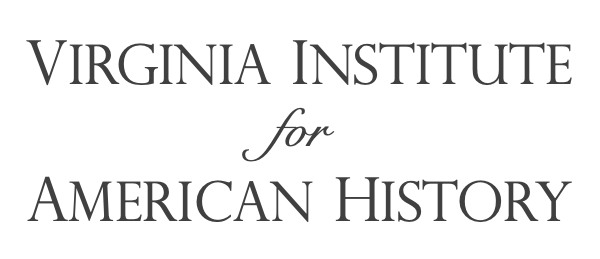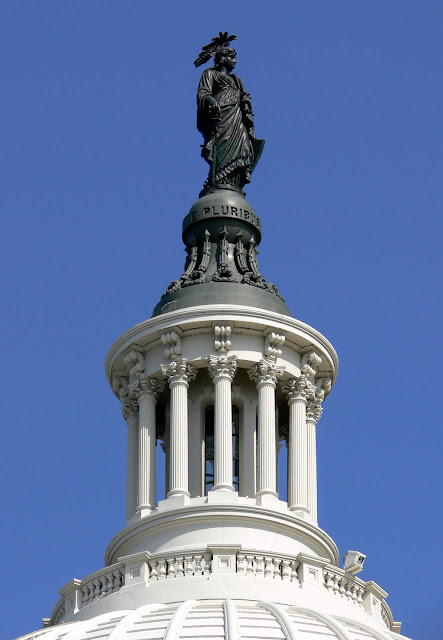Thursday, May 9, 2024
The Real American Revolution
Friday, March 29, 2024
The Right to Keep and Bear Arms

Monday, February 12, 2024
Statue of Freedom (U.S. Capitol)
Tuesday, January 23, 2024
The Founders and Slavery
I think the authors of that notable instrument [the Declaration of Independence] intended to include all men, but they did not mean to declare all men equal in all respects. They did not mean to say all men were equal in color, size, intellect, moral development or social capacity. They defined with tolerable distinctness in what they did consider all men created equal — equal in certain inalienable rights, among which are life, liberty and the pursuit of happiness. This they said, and this they meant. They did not mean to assert the obvious untruth, that all were then actually enjoying that equality, nor yet, that they were about to confer it immediately upon them. In fact, they had no power to confer such a boon. They meant simply to declare the right so that the enforcement of it might follow as fast as circumstances should permit.”[8]
The judge has alluded to the Declaration of Independence, and insisted that negroes are not included in that Declaration; and that it is a slander upon the framers of that instrument to suppose that negroes were meant therein; and he asks you: Is it possible to believe that Mr. Jefferson, who penned the immortal paper, could have supposed himself applying the language of that instrument to the negro race, and yet held a portion of that race in slavery? … I believe the entire records of the world, from the date of the Declaration of Independence up to within three years ago, may be searched in vain for one single affirmation, from one single man, that the negro was not included in the Declaration of Independence; I think I may defy Judge Douglas to show that he ever said so, that Washington ever said so, that any President [including Jefferson] ever said so, that any member of Congress ever said so, or that any living man upon the whole earth ever said so, until the necessities of the present policy of the Democratic party in regard to slavery had to invent that affirmation.
The new [Confederate] constitution has put at rest, forever, all the agitating questions relating to our peculiar institution African slavery as it exists amongst us the proper status of the negro in our form of civilization. This was the immediate cause of the late rupture and present revolution. Jefferson in his forecast, had anticipated this, as the “rock upon which the old Union would split.” He was right... The prevailing ideas entertained by him and most of the leading statesmen at the time of the formation of the old constitution, were that the enslavement of the African was in violation of the laws of nature; that it was wrong in principle, socially, morally, and politically. It was an evil they knew not well how to deal with, but the general opinion of the men of that day was that, somehow or other in the order of Providence, the institution would be evanescent and pass away. This idea, though not incorporated in the constitution, was the prevailing idea at that time... Those ideas, however, were fundamentally wrong. They rested upon the assumption of the equality of races. This was an error... Our new government is founded upon exactly the opposite idea; its foundations are laid, its cornerstone rests, upon the great truth that the negro is not equal to the white man; that slavery subordination to the superior race is his natural and normal condition....”[12]
Wednesday, October 18, 2023
George Washington and the Cherry Tree "Myth"
The author of the best-selling biography ever written about George Washington was Mason Weems.1 However, it seems to be a litmus test for an historian to be taken seriously that he or she must exhibit a condescending disdain for Weems’ content, especially his anecdote about Washington ruining his father’s cherry tree and confessing it. Hence, in his book, Where the Cherry Tree Grew (2013), University of South Florida history professor Philip Levy states that in recent years professional historians have agreed that “Knocking Weems was a way to show that one was ‘one of us,’ real, credible, truthful...”2 Surprisingly, then, this year on Presidents’ Day, Pulitzer Prize winning journalist and former president of the White House Correspondents’ Association, Carl M. Cannon, offered this caution against injudiciously “knocking Weems.”
In his widely acclaimed “Washington, a Life,” author Ron Chernow dismisses Weems as the man “who manufactured enduring myths about Washington refusing to lie about chopping down a cherry tree [and] hurling a silver dollar across the Rappahannock.” But just as we must be careful not to pass along hagiographic hokum when writing about politicians, so must we take care in our debunkings. There are several problems with dismissing these accounts as myths.3
In their new article, An Analysis of the Scholarly Consensus Regarding George Washington and the Cherry Tree “Myth,” James Bish & Richard Gardiner, Ph.D. look directly at the sources and scholarship and consider all the evidence piece by piece. In the end, the “myth” label on Weems' cherry tree story will forever be dispensed with by anyone who carefully considers these findings.
Enjoy reading: http://www.liberty1.org/weems6.pdf
_____________________________
1 Michael Kammen, “Introduction” in Douglas Southall Freeman, Washington (Collier Books, 1992), xvii; Hugh T. Harrington, “The History of Parson Weems,” The Journal of The American Revolution, September 25, 2013. Harrington states that only the Bible sold more than Weems’ biography of Washington in the years following its advent. (https://allthingsliberty.com/2013/09/history-parson-weems/).
2 Philip Levy, Where the Cherry Tree Grew: The Story of Ferry Farm, George Washington’s Boyhood Home (St. Martin’s Press, 2013), 159. Regarding the cherry tree story, Levy himself believes that “The evidence that the story is true is equal to the evidence that it is false.” (https://www.mountvernon.org/george-washington/facts/myths/george- washington-and-the-cherry-tree-myth/where-the-cherry-tree-grew-an-interview-with- phillip-levy/).
3 Carl M. Cannon, “Great American Stories: George Washington,” February 21, 2023. https://www.realclearpublicaffairs.com/articles/2023/02/21/great_american_stories_ george_washington_883017.html Carl Cannon is the son of the celebrated biographer of Ronald Reagan, Lou Cannon; for Cannon’s scholarly credentials see Harvard Kennedy School Institute of Politics https://iop.harvard.edu/fellows/carl-cannon. Cannon’s challenges to Weems’ critics extends the long dispute with a history of its own going back to at least the 1920s: “Dr. Barton Defends Cherry Tree Story: Weems Better than Lodge on Washington, He Says,” Boston Globe, March 10, 1927, 12. Pittsburgh Attorney Richard B. Tucker offered, “Defense of Parson Weems and His Cherry Tree Story,” at the Historical Society of Western Pennsylvania, Feb. 12, 1949. At the end of his life in 1953, Douglas Southall Freeman made this general comparison between Weems and his debunkers, “Parson Weems was far more nearly accurate in his appraisal than the debunkers have been.” Freeman, quoted by Kammen, “Introduction” in Douglas Southall Freeman, Washington (Collier Books, 1992), xvii. In 1956, Arthur H. Merritt refereed the dispute concluding that it remains an “open” issue. Arthur H. Merritt, “Did Parson Weems Really Invent the Cherry-Tree Story?” in New-York Historical Society Quarterly 40 (July 1956), 252-63. Merritt asked, “Why can’t this simple question be settled once and for all?” In 1962, Marcus Cunliffe surveyed the facts, pro and con, in his ”Parson Weems and George Washington's Cherry Tree,” Bulletin of the John Rylands Library; v. 45, without a verdict. The dispute was revived again in 2014: Paul Bedard, “Fight Erupts over George Washington Cherry Tree ‘Myth’,” Washington Examiner, March 14, 2014. Austin Washington, the first President’s great grandnephew is currently continuing the contest.
See also: https://www.mountvernon.org/library/digitalhistory/digital-encyclopedia/article/cherry-tree-myth/
Sunday, June 4, 2023
The Hand of Providence in the U. S. Constitution
“All of us who were engaged in the struggle must have observed frequent instances of superintending providence in our favor. To that kind providence we owe this happy opportunity of consulting in peace on the means of establishing our future national felicity. And have we now forgotten that powerful friend? Or do we imagine that we no longer need his assistance? I have lived, Sir, a long time, and the longer I live, the more convincing proofs I see of this truth-that God governs in the affairs of men. And if a sparrow cannot fall to the Ground without his Notice, is it probable that an Empire can rise without his Aid?”
Wednesday, May 3, 2023
What is the Meaning Behind the Statue of Liberty?
The idea for the Statue of Liberty came from Edouard Rene Lefebvre de Laboulaye, who conceived the idea of a monument gifted to America from France, as a symbol of their strong ties forged during the American Civil War. He hoped the statue could represent a centenary since America’s Declaration of Independence in 1776, along with the abolition of slavery in the same year, and could strengthen the relationship between the two nations. Laboulaye commissioned the renowned French sculptor and architect Frederic Auguste Bartholdi to design a colossal statue of profound significance, loaded with symbolism related to American history. A tablet in her left hand is inscribed with the date of the United States Declaration of Independence, while a broken shackle and chains at her feet represent liberty breaking the chains of bondage, or slavery in the United States.
A Symbol of the United States’ Multicultural Heritage
In the early 1900s, Georgina Shuyler was one of many to point out that the statue’s proximity to Ellis Island, and its visibility for ships and boats coming ashore, made it a powerful, welcoming symbol for immigrants entering the United States. In response to this new interpretation, the words from Emma Lazarus’s poem The New Colossus were famously etched into a plaque at the base of the statue in 1903, including the words: “Give me your tired, your poor, your huddled masses yearning to breathe free, the wretched refuse of your teeming shore.” It became recognized as a symbol of America’s rich multicultural history, founded by people from around the world...
The Statue of Liberty Is a Universal Symbol of Freedom and Liberty
Despite the complicated history of the United States, the statue has become universally recognized as a signifier for freedom and liberty around the world. Bartholdi designed his Lady Liberty to resemble Libertas, the Roman Goddess of Liberty. Many also believe he included a series of important, politically significant symbols to continue the theme. For example, the crown, with its rays extending outwards like the light of the sun, is believed to represent an open, welcoming light. Originally intended to be a lighthouse, the crown is now a viewing platform which visitors can enter to look out across the harbor. Some historians have argued the seven rays of the crown represent the seven seas and the seven continents, implying the global importance of liberty for all. Others believe the seven rays of her crown represent a series of seven vital freedoms: civil, moral, national, natural, personal, political and religious liberty.








